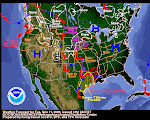By far the easiest place to learn about volcanoes is Wikipedia. This amazing online resource has most everything an armchair layman would ever want to know about volcanoes. Click here to start your volcano refresher. You will see many links on this "gateway" page. If you want to see just how destructive volcanoes have been during recorded history, go to this link. The Big Grand Daddy of recent volcanoes was Krakatoa.
 The old funky drawing on this page shows Krakatoa before it disintegrated. There's a famous year in American History called "The Year Without A Summer." It's widely believed that this epic time period was caused by volcanic activity. You can click here to read about "The Year Without A Summer." Obviously, there's enough links from those Wikipedia pages for you to get involved in hours and hours of self-study. I'd recommend that you fully acquaint yourself with all of the Wiki resources on volcanoes. If you are serious about watching weather, you really need to be very well grounded in the science of volcanic activity. You also need to know how to track current volcanic activity.
The old funky drawing on this page shows Krakatoa before it disintegrated. There's a famous year in American History called "The Year Without A Summer." It's widely believed that this epic time period was caused by volcanic activity. You can click here to read about "The Year Without A Summer." Obviously, there's enough links from those Wikipedia pages for you to get involved in hours and hours of self-study. I'd recommend that you fully acquaint yourself with all of the Wiki resources on volcanoes. If you are serious about watching weather, you really need to be very well grounded in the science of volcanic activity. You also need to know how to track current volcanic activity.Let's move into the tracking phase, shall we? As you might expect the US Geological Survey is the world leader in tracking volcanic activity. Click here to go to their gateway website. Be sure to bookmark that website. I think I will put it in the left hand column here, too. Check in on that website often--make it a regular habit, just like watching the jetstream. It's important to note that the mainstream media (that's defined as the media that's obsessed with celebrities and banal fluff) won't alert you to volcanic activity unless it's a huge event. In the meantime, minor volcanic activity can have a big impact on weather. For example, the Aleutian eruptions last summer received scant media coverage because the media was focused on the Obama-McCain-Palin-Biden quadrangle and who cared about some no-name volcano? However, those 3 volcanoes spewed enough stuff into the correct latitudes to really create a notable winter, a winter that generated all sorts of subsequent "media events."
Let's not rag on the media. Let's focus on improving your volcano-watcher skills. One of the largest concentrations of active volcanoes on earth is located on the Kamchatka Peninsula. As Gov. Winky Palin might say, "You can almost see it from Alaska." In any given year, the Kamchatka volcanoes have had and are capable of having an affect on our climate. It's a trifle difficult keeping track of Kamchatka volcanoes because of the language barrier.
 The graphic on this page shows just how many volcanoes are clustered on Kamchatka. Pretty impressive, eh? Click here to read about KVERT. KVERT is the Russian equivalent of the Alaska Volcano Observatory. Theoretically, the USGS and AVO work hand-in-hand with KVERT. One hopes that such cooperative efforts continue and remain productive and friendly. Luckily, satellite technology really unveils the activity and impacts of volcanoes in this day and age.
The graphic on this page shows just how many volcanoes are clustered on Kamchatka. Pretty impressive, eh? Click here to read about KVERT. KVERT is the Russian equivalent of the Alaska Volcano Observatory. Theoretically, the USGS and AVO work hand-in-hand with KVERT. One hopes that such cooperative efforts continue and remain productive and friendly. Luckily, satellite technology really unveils the activity and impacts of volcanoes in this day and age.There are many more ways to track volcanic activity. However, let's not ramble too much farther here today--it's now Recess Time! Thanks for attending Sunday School this week. Now GO PLAY!















No comments:
Post a Comment